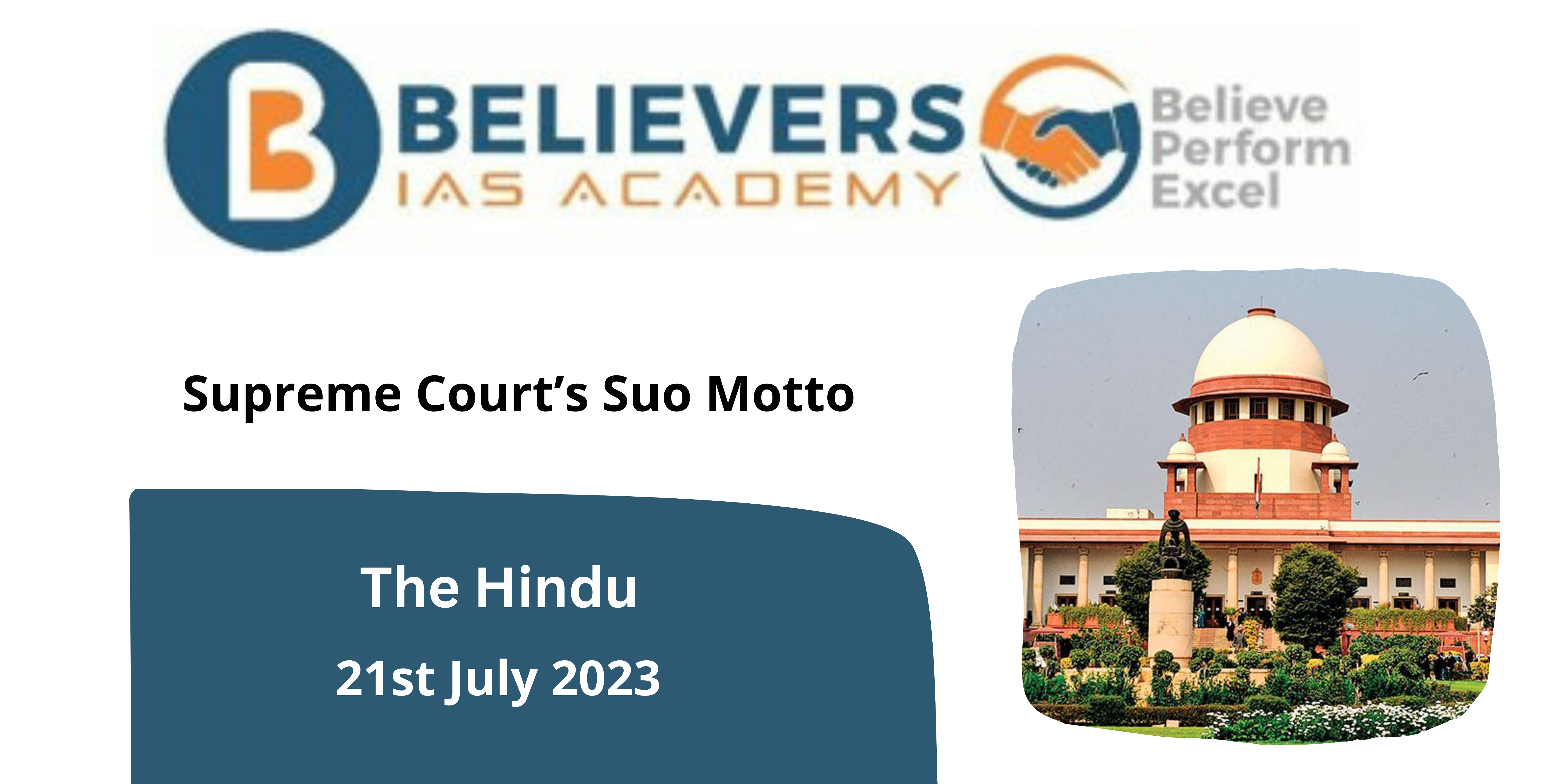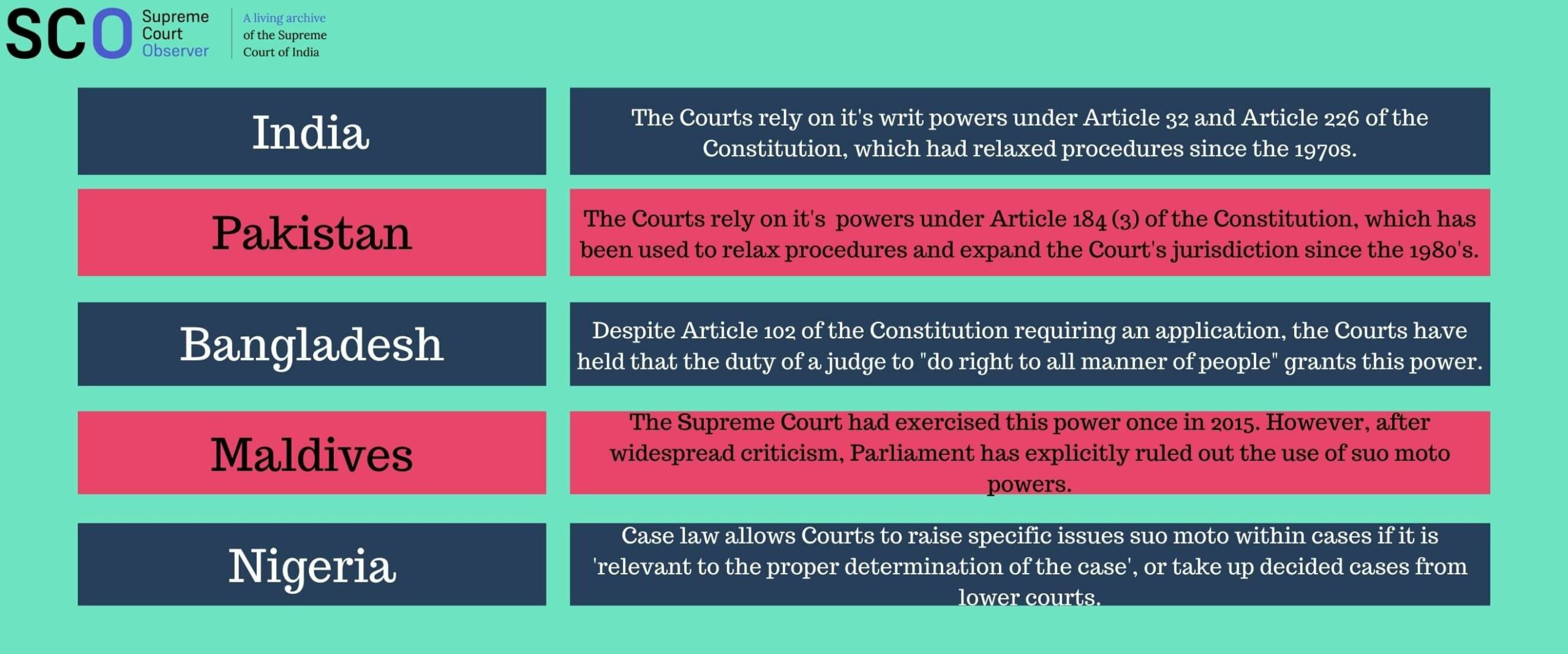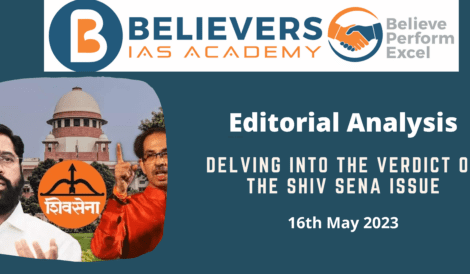Supreme Court’s Suo Motto
Context:
On Thursday, Chief Justice of India D.Y. Chandrachud called the Attorney-General and Solicitor-General of the government to express the court’s “deeply disturbed” response to a video showing two women being paraded naked and subjected to sexual abuse in conflict-ridden Manipur.
What is Suo Motto?
- Suo Moto Cognizance: In law, the term “suo moto cognizance” refers to the court’s authority to hear cases on its own initiative without any formal complaint or petition being submitted by any party. Based on information obtained from media reports, letters, or any other reliable source, the court starts the procedures on its own.
- Constitutional Provisions: According to Articles 32 and 226 of the Indian Constitution, the Supreme Court and High Courts in India have the ability to take suo moto cognizance of cases. The Supreme Court is given the authority to issue writs for the enforcement of basic rights by Article 32, and the High Courts are given the same authority by Article 226 within their respective spheres of jurisdiction.
- PILs: Public Interest Litigation(PIL), a procedure that enables people or social activists to approach the court on behalf of the public interest, is frequently linked with suo moto cognizance. This idea has increased the scope of the judiciary’s involvement in issues of social justice and public concern.
- Judicial Activism: Suo Moto Cognizance is regarded as an example of judicial activism, in which the judge takes proactive measures to solve pressing concerns that could otherwise go ignored or neglected. By taking on such cases, the courts hope to guarantee the prompt and effective administration of justice.
- Scope of Judicial Review: While typically requiring a petition from a person who has been wronged, the courts have occasionally taken suo moto cognizance to address improper orders or injustices.
What are the types of cases where Suo Moto can be applied?
- Suo Moto Cognizance in the Following Situations:
- Contempt of Court: Cases involving contempt of court, which may include deliberate disobedience of court orders or conduct that embarrass the court, can be taken suo moto cognizance by courts.
- Reopening of Old Cases: The court may reopen a closed case by taking suo moto cognizance if fresh, substantial evidence is discovered.
- Order Probes for New Cases: Based on information from affected parties or media reports, courts may launch inquiries or order investigations in cases where there is an apparent injustice being done to a person or a group of society.
- Protection of Fundamental Rights: Suo moto cognizance may be exercised in situations when a citizen’s fundamental rights have been violated.
- Matters of Public Interest: The court may get involved in situations that affect a broad segment of the community or have a significant amount of public interest.
What are some of the negative aspects of Suo Moto?
- Cross-border jurisdiction
-
-
- Courts have the authority to take Suo motu cognizance of a case that is already before another court or institution.
- This might cause confusion because several courts may use different strategies and timetables to handle the problem.
- Conflicting rulings and delays in addressing the issue can result from overlapping jurisdiction.
- Judges’ time may be wasted on activities that may have been more effectively organized through the use of current legal procedures.
-
- Political Sensitivity:
-
-
- Suo motu cognizance may be used by courts to take action in politically delicate cases.
- This raises questions about judicial authority and can be perceived as an attempt to sway the political landscape.
- Such measures might erode public confidence in the independence and impartiality of the judiciary.
- The participation of the court could be interpreted as benefiting its own interests rather than advancing the cause of Justice.
-
- Resource Allocation :
-
-
- Suo motu cognizance abuse can result in the ineffective use of judicial resources.
- The court may wind up handling issues that might have been better handled by administrative or current legal procedures.
- The judiciary’s ability to handle other urgent and important matters may be hampered as a result of this misallocation.
-
- Impeding Administrative Organizations:
-
- It can impede their operations when courts raise a matter already being handled by specialized administrative bodies or tribunals.
- Administrative entities may have the knowledge and experience necessary to effectively manage particular problems.
- Court intervention could throw off these specialist bodies’ well-organized procedures, resulting in delays and confusion.





